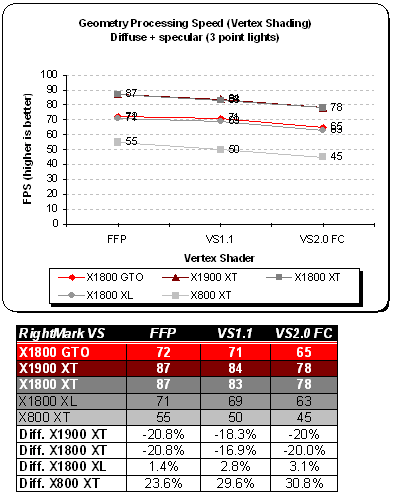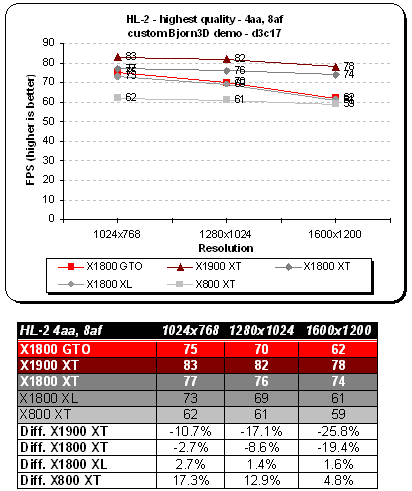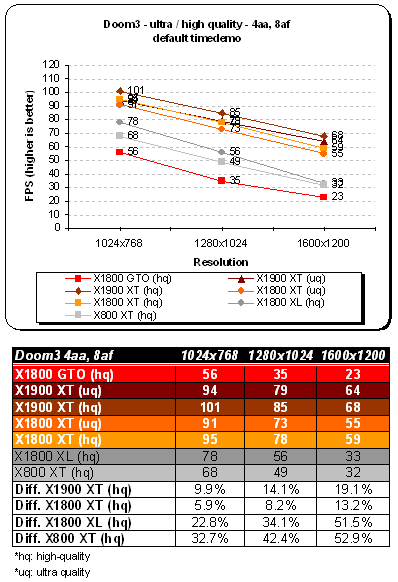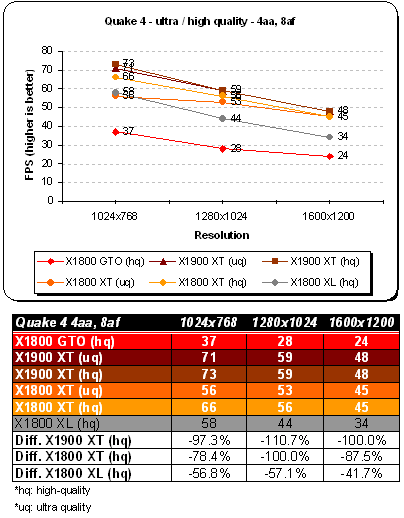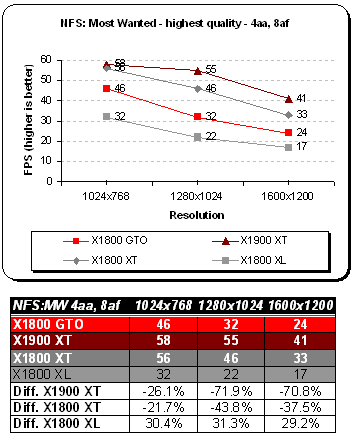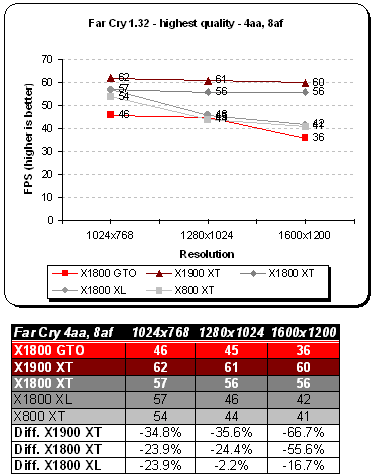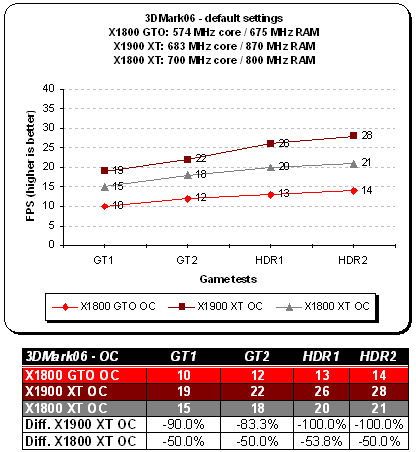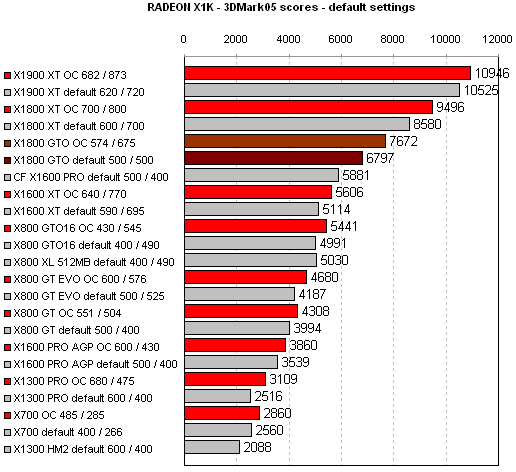Without a doubt, PowerColor X1800 GTO is one of the best performing cards in its class. RADEON R520 for $235 gives it a good performance / price ratio. If you’re lucky enough you might get a board with memory chips going all the way up to 675 MHz stable and artifact free (175 MHz over the limit) and if you’re very lucky you’ll be able to mod it to 16 pipelines.
Introduction
The last time I looked at a cut down version of high-end RADEON was with X800 GT from PowerColor. ATI had launched that particular SKU last year to compete with NVIDIA’s GeForce 6600GT and 6800LE series of cards. This year we have RADEON X1800 GTO going against GeForce 7600’s and X1900 GT later this summer. ATI’s X1800 GTO came in late to the game, it’s been delayed more than once and was supposed to be available at launch sometime in March. On the other side, NVIDIA’s GeForce 7600 was going at full force scoring major points and gaining trust among users.
Anyhow, Tul along other AIBs were first to ship GTOs for masses. Better late than never, I have PowerColor X1800 GTO on the bench for you to check out. Some of you might have already heard of GTO mods, but most of the time it’s impossible because of laser cuts which disable 1 quad. So how do they do it you ask? Well, some partners did not get much love from ATI on getting those laser locked GTO chips. Instead they’ve used leftover XL GPUs, flashed the cards with reworked BIOS and voilà! — a branded GTO. Now if you have the “special” card (check techpowerup.com on how to identify it) you just use this PowerColor X1800 XL BIOS, flash your board and enjoy 16 pipelines!
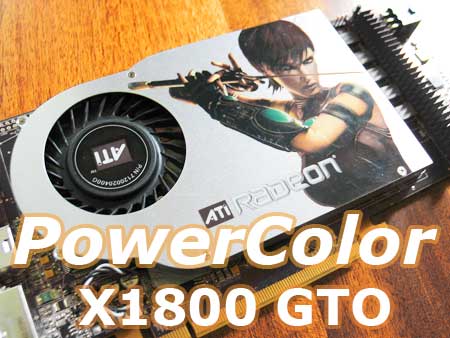
That should do it for the intro before I get to the benchmarks and other good stuff right? Ah, almost forgot…
For those not in the know Tul Corporation is a Tier-1 provider of ATI-based graphic cards. The company is also a leader in providing motherboards and barebone systems. So what about PowerColor?
PowerColor is a consumer brand focused on providing cutting-edge graphics card products to retail customers. Our goal for the Tul brand is to be the industry’s number one provider of technology product solutions. Our goal for the PowerColor brand is to be the world’s number one brand of graphics cards. PowerColor is in effect owned by Tul Corporation, however the brands are operated independently of each other.
VPU Specifications
As with every new generation of GPUs the feature set becomes larger and more complex. The newly introduced X1K family of products is exactly what we have here. Most importantly, the X1000 line now sports Shader Model 3.0 which has been available from NVIDIA for over a year now. As you can see from the table below, X1800 GTO is built around 90nm sillicon (just like XL) — so are mid-end and low-end chips. Due to inclusion of SM3.0, brand new memory controller, improved cache design and Z-buffer, transistor count has doubled compared to R420. ATi’s R520 now has ~320 million of those electronic switches.
| Video card |
PowerColor X1800 GTO | HiS X1800 XL |
| GPU (256-bit) | R520 | R520 |
| Chip Architecture | .09µ (TSMC fab) | .09µ (TSMC fab) |
| Transistors | ~320 Million | ~320 Million |
| Memory Architecture | 256-bit | 256-bit |
| Frame Buffer Size | 256 MB GDDR-3 | 256 MB GDDR-3 |
| Pixel Pipelines | 12 (3 quads) | 16 (4 quads) |
| Vertex Pipelines | 8 | 8 |
| TMU(s) per Pipeline | 1 | 1 |
| Engine | Ultra-threaded architecture | Ultra-threaded architecture |
| Bus Type | PCI-e 16x | PCI-e 16x |
| Core Clock | 500 MHz |
500 MHz |
| Memory Clock | 1000 MHz DDR |
1000 MHz DDR |
| RAMDACs | 2x 400 MHz DACs | 2x 400 MHz DACs |
| Memory Bandwidth | 32 GB / sec | 32 GB / sec |
| Pixel Fillrate | 6 GPixels / sec | 8 GPixels / sec |
| Texel Fillrate | 6 GTexels / sec | 8 GTexels / sec |
| DirectX Version | 9.0c | 9.0c |
| Pixel Shader | 3.0 | 3.0 |
| Vertex Shader | 3.0 | 3.0 |
The biggest of all changes is the introduction of what ATi calls Ultra-Threading Dispatch Processor and Ring Bus (old SMARTSHADER). Without going into much detail here, the dispatch processor (as the name implies) routes or relegates the workload to four pixel shader cores (also known as Quads). Each quad consists of four mini-pixel processors. The process between them is called threading and means:
- Large Scale Multi-threading
- Hundreds of simultaneous threads across multiple cores
- Each thread can perform up to 6 different shader instructions on 4 pixels per clock cycle
- Small Thread sizes
- 12 pixels per thread in Radeon X1800
- Fine-grain parallelism
- Fast Branch Execution
- Dedicated units handle flow control with no ALU overhead
- Large Multi-Ported Register arrays
- Enables fast thread switching
Now the Ring Bus technology. This isn’t Marry-go-around or anything like that — well sort of. The bus itself consists of two 256-bit rings which run in the opposite direction. This way routing latencies are reduced to a bare minimum and clockrate scaling is far more efficient. Among other things we have:
- New cache design – fully associative for more optimal performance
- Improved Hyper-Z – better compression and hidden surface removal
- Programmable arbitration logic – maximizes memory efficiency and can be upgraded via software
X1800 GTO specifications
Features:
-
- 320 million transistors on 90nm fabrication process
- Ultra-threaded architecture with fast dynamic branching
-
12 pixel shader processors
- 8 vertex shader processors
- 256-bit 8-channel GDDR3/GDDR4 memory interface
- Native PCI Express x16 bus interface
- Dynamic Voltage Control
- Ring Bus Memory Controller
-
- 512-bit internal ring bus for memory reads
- Programmable intelligent arbitration logic
- Fully associative texture, color, and Z/stencil cache designs
- Hierarchical Z-buffer with Early Z test
- Lossless Z Compression (up to 48:1)
- Fast Z-Buffer Clear
- Z/stencil cache optimized for real-time shadow rendering
- Optimized for performance at high display resolutions, including widescreen HDTV resolutions
- Ultra-Threaded Shader Engine
-
- Support for Microsoft® DirectX® 9.0 Shader Model 3.0 programmable vertex and pixel shaders in hardware
- Full speed 128-bit floating point processing for all shader operations
- Up to 512 simultaneous pixel threads
- Dedicated branch execution units for high performance dynamic branching and flow control
- Dedicated texture address units for improved efficiency
- 3Dc+ texture compression
- High quality 4:1 compression for normal maps and two-channel data formats
- High quality 2:1 compression for luminance maps and single-channel data formats
- Multiple Render Target (MRT) support
- Render to vertex buffer support
- Complete feature set also supported in OpenGL® 2.0
- Advanced Image Quality Features
-
- 64-bit floating point HDR rendering supported throughout the pipeline
- Includes support for blending and multi-sample anti-aliasing
- 32-bit integer HDR (10:10:10:2) format supported throughout the pipeline
- Includes support for blending and multi-sample anti-aliasing
- 2x/4x/6x Anti-Aliasing modes
- Multi-sample algorithm with gamma correction, programmable sparse sample patterns, and centroid sampling
- New Adaptive Anti-Aliasing feature with Performance and Quality modes
- Temporal Anti-Aliasing mode
- Lossless Color Compression (up to 6:1) at all resolutions, including widescreen HDTV resolutions
- 2x/4x/8x/16x Anisotropic Filtering modes
- Up to 128-tap texture filtering
- Adaptive algorithm with Performance and Quality options
- High resolution texture support (up to 4k x 4k)
- 64-bit floating point HDR rendering supported throughout the pipeline
- Avivo™ Video and Display Platform
-
- High performance programmable video processor
- Accelerated MPEG-2, MPEG-4, DivX, WMV9, VC-1, and H.264 decoding and transcoding
- DXVA support
- De-blocking and noise reduction filtering
- Motion compensation, IDCT, DCT and color space conversion
- Vector adaptive per-pixel de-interlacing
- 3:2 pulldown (frame rate conversion)
- Seamless integration of pixel shaders with video in real time
- HDR tone mapping acceleration
- Maps any input format to 10 bit per channel output
- Flexible display support
- Dual integrated dual-link DVI transmitters
- DVI 1.0 compliant / HDMI interoperable and HDCP ready
- Dual integrated 10 bit per channel 400 MHz DACs
- 16 bit per channel floating point HDR and 10 bit per channel DVI output
- Programmable piecewise linear gamma correction, color correction, and color space conversion (10 bits per color)
- Complete, independent color controls and video overlays for each display
- High quality pre- and post-scaling engines, with underscan support for all outputs
- Content-adaptive de-flicker filtering for interlaced displays
- Xilleon™ TV encoder for high quality analog output
- YPrPb component output for direct drive of HDTV displays
- Spatial/temporal dithering enables 10-bit color quality on 8-bit and 6-bit displays
- Fast, glitch-free mode switching
- VGA mode support on all outputs
- Drive two displays simultaneously with independent resolutions and refresh rates
- Dual integrated dual-link DVI transmitters
- Compatible with ATI TV/Video encoder products, including Theater 550
- High performance programmable video processor
- CrossFire™
-
- Multi-GPU technology
- Four modes of operation:
- Alternate Frame Rendering (maximum performance)
- Supertiling (optimal load-balancing)
- Scissor (compatibility)
- Super AA 8x/10x/12x/14x (maximum image quality)
The Card
RADEON X1800 GTO and X1800 XL look alike. In a sense they are the same cards just carrying a “different” chip. That silicon can be either a full fledged R520 (unlockable) or locked up R520 with disabled quads and texture units — it all depends on the vendor and which chips they get. Some AIBs will actually sell X1800 XLs branded as GTOs, the catch is they come with custom BIOS which disables 4 pixel pipelines. If you’re lucky enough to get the card you should be golden to unlock it. Anyway, the size of both cards is the same, so is the length. Obviously you won’t find XL sticker, but that’s a cosmetic change.
Click a picture to see a larger view
As I’ve mentioned before, physically GTOs are the same size as XLs. They come with the back brace which holds the HSF in place. The cooling system is not too loud, but when fan is cranked up it can get noisy. The back bracket features dual DVI links and VIVO support. The card carries a standard display support: VGA compatible, VESA compatible BIOS for SVGA and DDC 1/2b/2b+
As all high-end boards these days this one also carries an external power supply socket. The above are 6-pin PCI-e connectors so make sure you plug in more juice, otherwise the card wont boot. Notice voltage regulators are also there covered with anodized heatsink.
PowerColor X1800 GTO features Avivo technology:
- Avivo™ Video and Display Platform
-
- High performance programmable video processor
- Accelerated MPEG-2, MPEG-4, DivX, WMV9, VC-1, and H.264 decoding and transcoding
- DXVA support
- De-blocking and noise reduction filtering
- Motion compensation, IDCT, DCT and color space conversion
- Vector adaptive per-pixel de-interlacing
- 3:2 pulldown (frame rate conversion)
- Seamless integration of pixel shaders with video in real time
- HDR tone mapping acceleration
- Maps any input format to 10 bit per channel output
- Flexible display support
- Dual integrated dual-link DVI transmitters
- DVI 1.0 compliant / HDMI interoperable and HDCP ready
- Dual integrated 10 bit per channel 400 MHz DACs
- 16 bit per channel floating point HDR and 10 bit per channel DVI output
- Programmable piecewise linear gamma correction, color correction, and color space conversion (10 bits per color)
- Complete, independent color controls and video overlays for each display
- High quality pre- and post-scaling engines, with underscan support for all outputs
- Content-adaptive de-flicker filtering for interlaced displays
- Xilleon™ TV encoder for high quality analog output
- YPrPb component output for direct drive of HDTV displays
- Spatial/temporal dithering enables 10-bit color quality on 8-bit and 6-bit displays
- Fast, glitch-free mode switching
- VGA mode support on all outputs
- Drive two displays simultaneously with independent resolutions and refresh rates
- Dual integrated dual-link DVI transmitters
- Compatible with ATI TV/Video encoder products, including Theater 550
- High performance programmable video processor
Bundle
The card came in a shiny silvery box — pretty neat since most of PowerColor cards come in a regular carton with some chick on it. The front and back highlight cards specifications and features. The back of the box sports specs and some catch phrases. The sides show system requirements.
One thing they’ve added is Crossfire information sticker as well as X1K main features sticker which seems to appear on most of current ATI products
Click a picture to see a larger view
When it comes down to cables, PowerColor includes the same set of wires found on X850 XT PE, X1800 XT & X1900 XT:
Accessories
- Composite cable
- Power cable
- S-Video cable
- HDTV cable
- VIVO cable
- DVI-I connector
- Quick start manual
Software
- ATI drivers
- CyberLink DVD Solutions
- PowerDVD 5
- PowerProducer 2 Gold
- DVD PowerDirector 3
- Power2Go 3 Medi@show 2
Setup and Installation
All of our benchmarks were ran on Athlon64 3000+ system @ 2.5GHz. The reason I decided to up the CPU clock for R580/R520 is the fact that default clocks would be limiting the cards by a whole lot. It still is limiting at low resolutions in some benchmarks, but I’ve tried to create as little bottlenecked environment as possible.
I will take this X1800 GTO from PowerColor for a spin along with some other cards including X1900 XT, X1800 XT, X1800 XL and reference design ATi X800 XT. The table below shows test system configuration as well benchmarks used throughout the review.
| Components | – DFI NF4 Ultra-D – Athlon64 3000+ Venice – G.Skill F1-4000BIU2-2GBHV DDR500 – Thermaltake Toughpower 550 Watt PSU – PowerColor X1800 GTO 256 MB – PowerColor X1900 XT 512 MB – PowerColor X1800 XT 512 MB – HiS X1800 XL 256 MB – ATi X800 XT 256 MB |
| Software | – Windows XP SP2 – DirectX 9.0c – nForce4 6.53 drivers – CATALYST 6.4 |
| Synthetic Benchmarks | – 3DMark 2005 v1.2.0 – 3DMark 2006 – D3D Right Mark 1.0.5.0 beta 4 |
| Gaming Benchmarks | – F.E.A.R / ingame benchmark + Fraps – Half-Life 2 / custom d13c17 timedemo + Fraps – Doom 3 / default timedemo + Fraps – Quake 4 / custom timedemo – NFS: Most Wanted / Fraps – Far Cry 1.32 / custom timedemo + Fraps |
| Notes | For R5x0 CPU was clocked at 2.5GHz to reduce limitation |
Because X1800 GTO / X1800 XL are long cards you have to make sure you have sufficient room inside your case. If you don’t then you need to clear the way for this card — relocate your HDs for example or in the worst scenario buy a bigger case.
Installation went smoothly. Just popped the card in and turned it on. As most fans on high-end boards these days it’s not a quiet solution, but not loud either comapred to X18(9)00 XT(X). The sound is rather pleasing in 2D mode, but when going into 3D with additional overclock it can get loud.
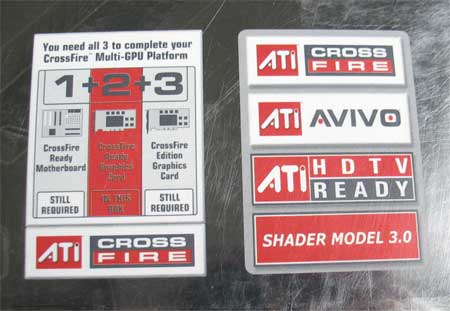
Crossfire information on the front of the box
3DMark05 / 06
I’ve used Futuremark’s 3DMark 2005 to measure the actual throughput of our PowerColor X1800 GTO and compared it against other high-end boards. Additionally I’m including scores from Futuremark’s newest 3DMark06.

X1800 GTO, X1900 XT, X1800 XT, X850 XT PE (PowerColor), X800 XT (ATI reference)
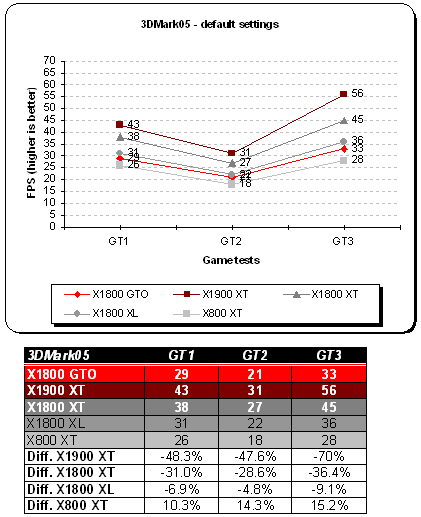
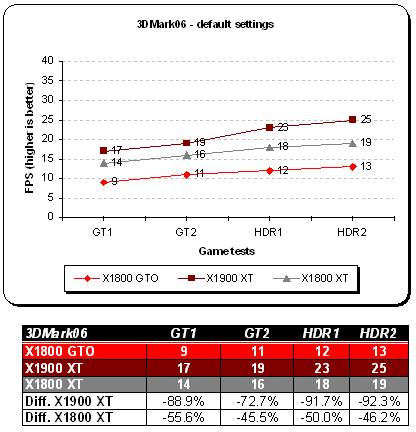
RightMark
With D3D RightMark you will be able to get the following information about your video card:
- Features supported by your video card
- Pixel Fillrate and Texel Fillrate
- Pixel shader processing speed (all shader models)
- Vertex shader (geometry) processing speed (all shader models)
- Point sprites drawing speed
- HSR efficency
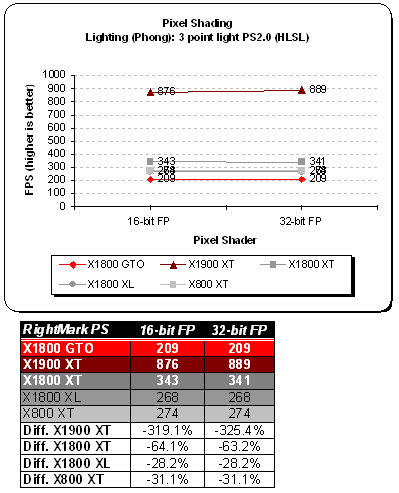
F.E.A.R
Game Overview
An unidentified paramilitary force infiltrates a multi-billion dollar aerospace compound, taking hostages but issuing no demands. The government responds by sending in special forces, but loses contact as an eerie signal interrupts radio communications. When the interference subsides moments later, the team has been obliterated. As part of a classified strike team created to deal with threats no one else can handle, your mission is simple: Eliminate the intruders at any cost. Determine the origin of the signal. And contain the crisis before it spirals out of control.
As you probably know, F.E.A.R uses a very sophisticated game engine (FEAR).
- Rendering
- FEAR is powered by a new flexible, extensible, and data driven DirectX 9 renderer that uses materials for rendering all visual objects. Each material associates an HLSL shader with artist-editable parameters used for rendering, including texture maps (normal, specular, emissive, etc.), colors, and numeric constants.
- Lightning Model
- FEAR features a unified Blinn-Phong per-pixel lighting model, allowing each light to generate both diffuse and specular lighting consistently across all solid objects in the environment. The lighting pipeline uses the following passes:
- Emissive: The emissive pass allows objects to display a glow effect and establishes the depth buffer to improve performance.
- Lighting: The lighting pass renders each light, first by generating shadows and then by applying the lighting onto any pixels that are visible and not shadowed.
- Translucency: The translucent pass blends all translucent objects into the scene using back to front sorting.
- FEAR features a unified Blinn-Phong per-pixel lighting model, allowing each light to generate both diffuse and specular lighting consistently across all solid objects in the environment. The lighting pipeline uses the following passes:
- Visual Effects
- FEAR features a new optimized, data driven effects system that allows for the creation of key-framed effects that can be comprised of dynamic lights, particle systems, models, and sounds. Examples of the effects that can be created using this system include weapon muzzle flashes, explosions, footsteps, fire, snow, steam, smoke, dust, and debris.
- Sample Lights
- FEAR’s lighting model is very flexible and allows developers to easily add new lights. Existing lights include:
- Point Light: The point light is a single point that emits light equally in all directions.
- Spotlight: Similar to a flashlight, the spotlight projects light within a specified field of view. The spotlight can also use a texture to tint the color of the lighting on a per pixel basis.
- Cube Projector: Similar to the point light, the cube projector uses a cubic texture to tint each lit pixel.
- Directional Light: This lighting is emitted from a rectangular plane and is used to simulate directional lights like sunlight.
- Point Fill: Although similar to the point light, the point fill is an efficient option because it does not utilize specular lighting or cast shadows.
- FEAR’s lighting model is very flexible and allows developers to easily add new lights. Existing lights include:
A more detailed overview of other F.E.A.R technologies can be found over at Touchdown Entertainment. These include: Havok Physics Engine and Modeling / Animations System.

Half-Life 2
We all love Half-Life 2 and we all want best performance out of our hardware. This has to be one of the most graphic demanding games currently on the market. Half-Life 2 is built around Source engine which utilizes a very wide range of DirectX 8 / 9 special effects. Those include:
- Diffuse / specular bump mapping
- Dynamic soft shadows
- Localized / global valumetric fog
- Dynamic refraction
- High Level-of-Detail (LOD)
Note that users with DirectX 7 and older hardware (NVIDIA MX series for example) will not be able to enjoy the above effects. Let’s see how middle-end / low-end X1K graphic cards perform.
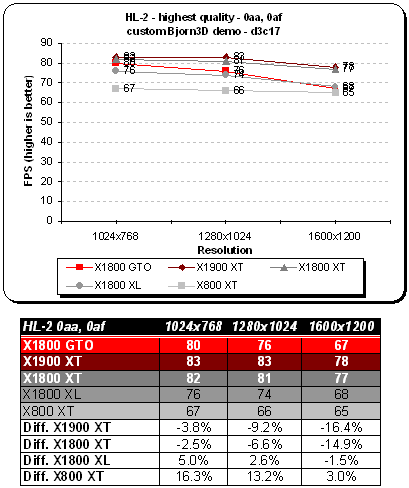
Doom 3
Although this game needs no introduction, I will go over some of the game features and technology behind Doom 3. It took the guys at id Software over four years to complete this project. Lead programmer, John Carmack spent an awful lot of time designing the game engine, but his hard work paid off — to some extent since this is first title which houses Doom 3 engine.
Let’s look at some of the engine tech features which are present in Doom 3:
- Unified lightning and shadowing engine
- Dynamic per-pixel lightning
- Stencil shadowing
- Specular lightning
- Realistic bumpmapping
- Dynamic and ambient six-channel audio
However you look at it, Carmack’s lightning engine is the essence of Doom 3. With OpenGL being the primary API, shaders have been put to a heavy use in order to create the realisticly looking environment. Instead of using lightmaps the game engine now processes all shadows in real-time. This technique is called stencil shadowing which can accurately shadow other objects in the scene. There are disadvantage to this method however:
- Requires a lot of fillrate
- Fast CPU is needed for shadow calculations
- Inability to render soft shadows
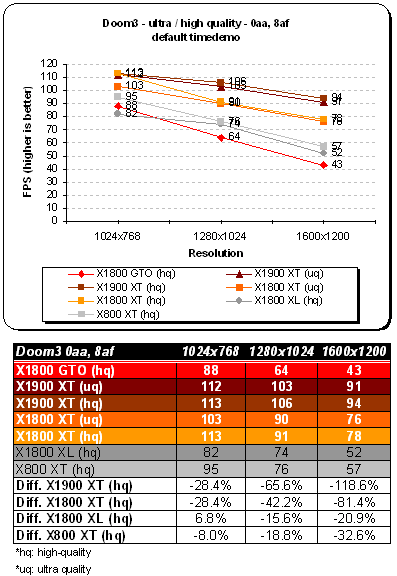
Quake 4
This is another good title worth looking at. With success of Quake 3, id Software decided (after few years) it would be proper to have a sequel. Designed over at Raven Software’s farm, Q4 features rich single player as well as intensive and popular multiplayer mode.
It uses Doom 3 engine so you should be familiar with available effects. In any case, I listed them below
- Unified lightning and shadowing engine
- Dynamic per-pixel lightning
- Stencil shadowing
- Specular lightning
- Realistic bumpmapping
- Dynamic and ambient six-channel audio

Need For Speed: Most Wanted
We have quite a few sequels in this review and this is another one, this time from Electronic Arts. If you’ve played NFS Hot Pursuit you know what I’m talking about. There are a lot of ideas taken out from the older NFS. The main difference between Most Wanted and Underground (in terms of graphics) is addition of HDR-type effects. It’s pseudo-HDR (more like bloom), but looks lovely nonetheless. Additionally the game sports flashy new reflections, better object geometry, improved lightning system and finally physics engine.
On the prvious page I showed you how X1K line performs in NFS: Underground 2. Here we have a fresh new title with bells and whistles waiting to get benched.
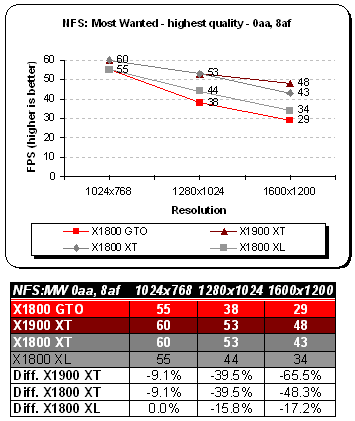
Far Cry 1.32
The company behind this game is Crytek. It was pretty much the first title which used a heavy load of PS 2.0 shaders. For our benching purposes we are using the full version with the newest 1.32 patch applied (mainly fixes SM 3.0 issues that caused graphic corruption on newer ATI hardware). Anyone who played this title will admire the draw distance, beautiful outside vegetation and incredibly spooky indoor environment. The game also features topnotch self-learning A.I and very realistic physics.
Far Cry’s CryEngine is pretty scalable, however you’d need at least DirectX 8 class hardware to enjoy the refractive water effects, ripples, real time per-pixel lighting, specular bump-mapping or volumetric effects.
The map of choice was Research. It’s a high-polygon map with both outdoor and indoor environment.
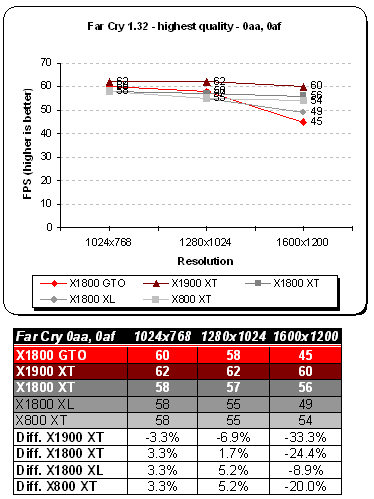
Overclocking
Most of our PowerColor samples overclocked nicely. I have found X1800 XT to overclock better than X1900 XT. How far will I be able to push this GTO? Let’s find out. One worthy note, X1800 GTO does not use 2D / 3D clocks meaning there is only 1 level of clockrates to be taken care of.
Before I go into scores let me talk a little about what we’re dealing with. As far as core speed is involved it’s clocked at 500 MHz (just like XL). PowerColor X1800 GTO carries 256 MBs of SAMSUNG K4J55323QG GDDR3 memory. Rated at 2.0ns it maxes out at 500 MHz (1000 MHz DDR)…supposedly 🙂 Core should be able to overclock as good as on XL, but we’ll see.
I was able to poke this GTO core from 500 to 574 MHz (default voltages), above that artifacts started to appear which is certainly not a good sign. A 6 minute burn in test with ATITool and a run of 3DMark05 gave good results. Next up was memory overclocking. It was a fun task which brought a little smile on my face. From a default frequency of 500 MHz the chips went to astonishingly stable 675 MHz (1350 MHz DDR, default voltages). Now looking at various reviews, I haven’t found a single GTO which memory OC’ed so well.
Below are 3DMark05 / 06 scores representing the performance of our overclocked X1800 GTO.
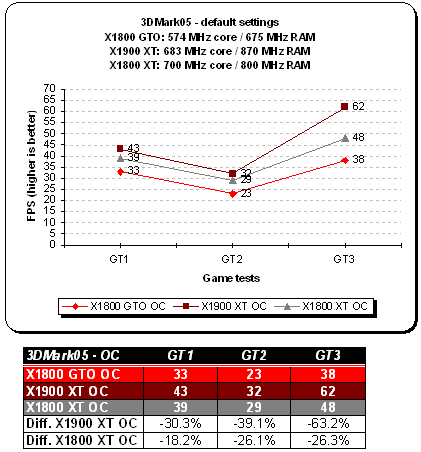
Conclusions
Without a doubt, PowerColor X1800 GTO is one of the best performing cards in its class. Bringing the price point of R520 to $235 gives it a good run for the money. Obviously there are drawbacks to it such as less PS units / textures / ROPs, but if you cannot shell out ~$320 green for XL it’s the best money can buy. Maybe you’ll be lucky enough and get the “special” moddable card? Let’s not forget these cards can overclock damn well which gives a substantial performance boost in most titles. The sample I’ve received had its memory going all the way up to 675 MHz stable and artifact free (175 MHz over the limit). I’m hoping more of those GTOs can pull that on stock voltages.
If I were to recommend this card to someone it would definitely be people entering the gaming scene, something above entry level with a bit of more juice. Let us not forget about Crossfire, Avivo and HDTV support which is carried by the GTO. We are certainly hoping to see X1800 GTO16 soon on the market — this has been already done by Tul with their PowerColor X800 GTO16 so keep your eyes opened.
Pros:
+ Good run for the money
+ Awsome memory overclock
+ Avivo/HDTV ready
+ Dual DVI
+ Nice package
+ Less power draw than XL
Cons:
– Outdated and weak bundle
– Late into the market
For solid performance in its class, PowerColor X1800 GTO get the rating of 9.0 (Extremely Good) out of 10 and Bjorn3D.com Seal of Approval Award.
 Bjorn3D.com Bjorn3d.com – Satisfying Your Daily Tech Cravings Since 1996
Bjorn3D.com Bjorn3d.com – Satisfying Your Daily Tech Cravings Since 1996











